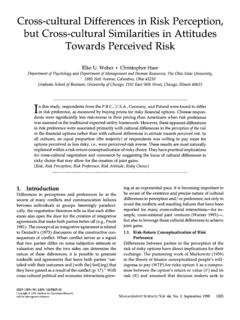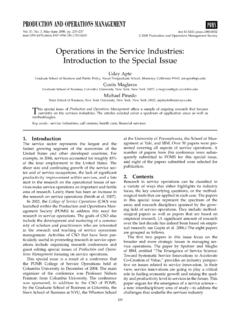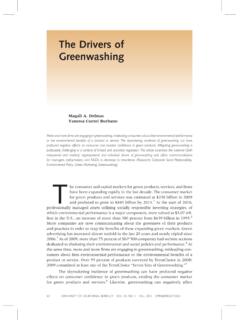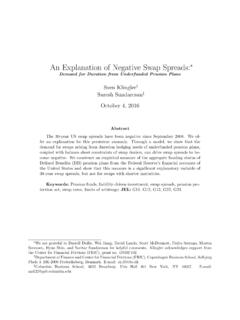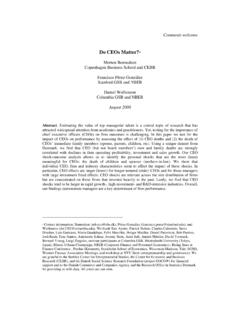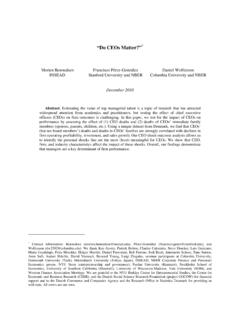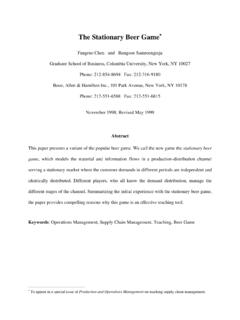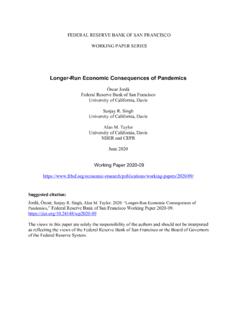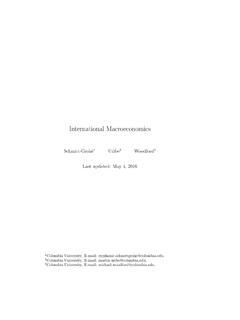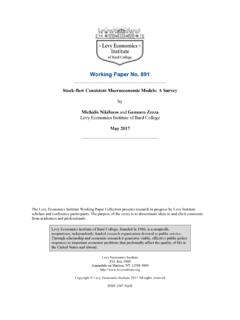Transcription of Rising Government Debt: Causes and Solutions for a Decades ...
1 Journal of Economic Perspectives Volume 33, Number 2 Spring 2019 Pages 115 140 Since US Government debt as a fraction of GDP reached a trough in the mid-1970s, it has been on a generally upward trajectory. As shown in Figure 1, it is now approaching levels not reached since World War II, and is projected to continue to increase significantly over the coming decade (Congressional Budget Office 2018, table ). This is largely the result of a secular expansion of Government spending in particular, mandatory spending programs such as Social Security, Medicare, and Medicaid (as discussed in Blahous 2013) with tax revenue not Rising as rapidly.
2 Between 1968 and 2017, spending on these three categories as a share GDP increased by an average annual rate of percent, while tax revenue as a share of GDP grew by an average annual rate of percent (based on Congres-sional Budget Office 2018, tables and ).The United States is not alone. Advanced economies as a group have experi-enced a long-term increase in Government debt to GDP, with France and Germany singled out as examples in Figure 2. The increase in Government debt in most of these countries is also the result of tax revenue not keeping pace with the expansion of Government spending.
3 For example, between 1972 and 2016, central Government tax revenue as a share of GDP increased in France, in Germany, and, more broadly, in the Organisation for Economic Cooperation and Development countries (based on World Bank data). Rising Government Debt: Causes and Solutions for a Decades -Old Trend Pierre Yared is a Professor of Business at Columbia Business School and a Director of the Richard Paul Richman Center for Business, Law, and Public Policy at Columbia University, New York, New York. His email address is For supplementary materials such as appendices, datasets, and author disclosure statements, see the article page doi= Yared116 Journal of Economic PerspectivesLarge debt buildups can eventually lead to diminished economic activity, either by crowding out private capital investment or by forcing an increase in distortive taxes and a decrease in public investment to facilitate Moreover.
4 A Government carrying such a high debt load may be constrained in responding to future catastrophes, such as financial crises, natural disasters, or wars (see Obst-feld 2013; Battaglini and Coate 2016; Romer and Romer 2018). In extreme cases, the result is default through explicit debt repudiation or inflation. There are many historical cases of default in advanced economies (Reinhart, Reinhart, and Rogoff 2015). The costs of default include increased stress on financial institutions, lower international financing for domestic firms, and decreased export market access (for discussion, see Borensztein and Panizza 2008; H bert and Schreger 2017 and the references cited therein).
5 Has the rise in Government debt over the past four Decades served a socially beneficial purpose that would compensate for the risks of the added debt burden? In the first part of this article, I review normative macroeconomic theories in which Government debt serves three possible functions: it can facilitate tax-smoothing, provide a safe asset, or sustain dynamic efficiency. I argue that, while the increased debt in certain periods may have been an optimal response to specific 1 For an analysis of the empirical relationship between economic growth and public debt, see Reinhart, Reinhart, and Rogoff (2012) in this journal and Eberhardt and Presbitero (2015).
6 Figure 1 Gross Debt of the US Government (pe rce nt)Source: Government debt to GDP is gross central Government debt as a percentage of GDP from Reinhart and Rogoff (2011) for 1790 2010, updated for 2011 2017, with the growth rate in debt to GDP from the International Monetary : I focus on gross central Government debt as this measure is available for the broadest cross-section of advanced economies. But for the United States, all empirical observations in the paper are robust to replacing this gross measure with federal debt held by the debt/GDP18001850190019502000 Pierre Yared 117macroeconomic shocks, the broad-based long-run trend in debt accumulation seems inconsistent with these theories of optimal Government debt then review political economy theories of Government debt.
7 I argue that an increasingly older population, Rising political polarization, and Rising electoral uncer-tainty can explain the long-run trend in Government debt across advanced economies. A resonating theme of these political economy theories is the time-inconsistency of Government policy. Current governments want to be fiscally irresponsible, while simul-taneously hoping that future governments will be fiscally responsible. Thus, governments across the world have adopted fiscal rules such as mandated deficit, spending, or revenue limits to curtail future increases in govern-ment debt.
8 In 2015, 92 countries had fiscal rules in place, a dramatic increase from 1990, when only seven countries had them (Lled , Yoon, Fang, Mbaye, and Kim 2017). Fiscal rules must balance commitment not to overspend with flexibility to react to shocks. In the final part of this article, I describe some recent research on the optimal design of fiscal rules, elucidating the commitment-versus-flexibility tradeoff in theory and in practice. This discussion touches on how rules should be conditioned on public information, how they should be enforced, how they should be applied at a supranational level, whether they should feature escape clauses, and whether they should be based on fiscal policy tools or 2 Government Debt in Advanced Economies(pe rce nt)Source.
9 Government debt to GDP is gross central Government debt as a percentage of GDP from Reinhart and Rogoff (2011) for 1960 2010, updated for 2011 2017 with the growth rate in debt to GDP from International Monetary Fund. GDP is from Feenstra, Inklaar, and Timmer (2015) for 1960 2014, and the 2014 GDP weight is assigned to 2015 2017. Note: The sample of advanced economies is a balanced panel which includes Australia, Austria, Belgium, Canada, Denmark, Finland, France, Germany, Greece, Iceland, Ireland, Italy, Japan, Netherlands, New Zealand, Norway, Portugal, Spain, Sweden, Switzerland, United Kingdom, and United States.
10 The line for advanced economies (excluding the US) represents the GDP-weighted average for each observation year. 20406080100 Government debt/GDP196019701980199020002010 United StatesAdvanced economies (excluding US)FranceGermany118 Journal of Economic PerspectivesOptimal Government Debt PolicyBehind any theory of optimal Government debt lurks the Ricardian equiva-lence proposition (Barro 1974). This proposition states that the level of Government debt is irrelevant and has no effect on real economic activity because Government borrowing can be undone by private actors.
